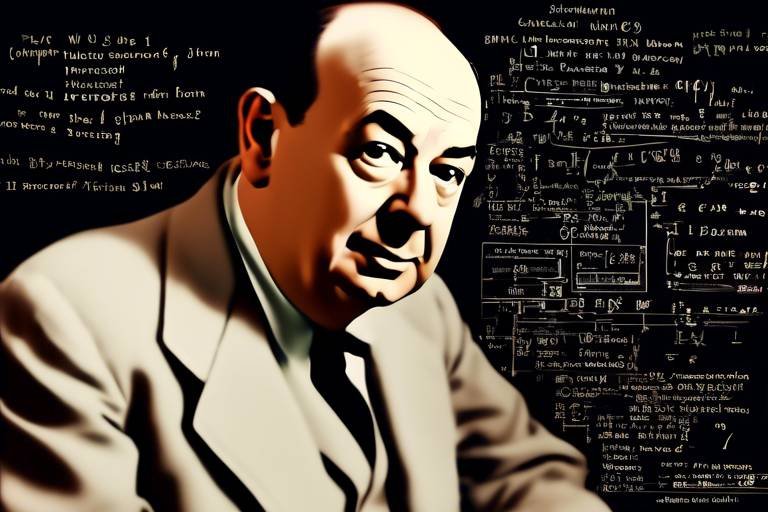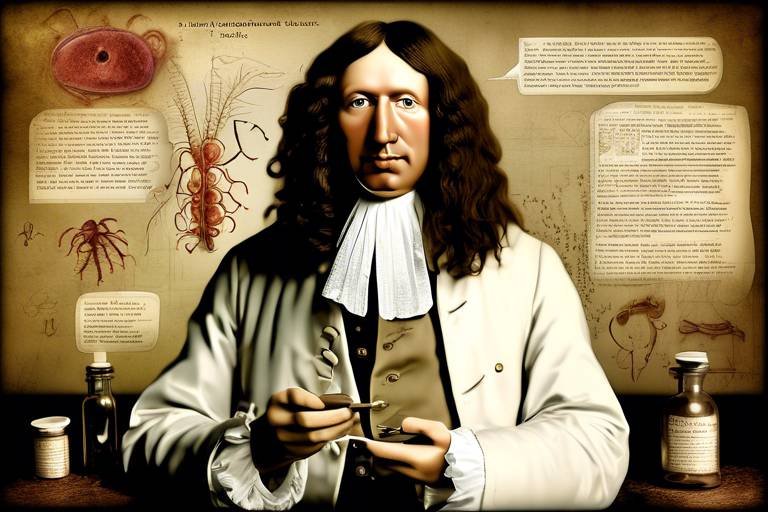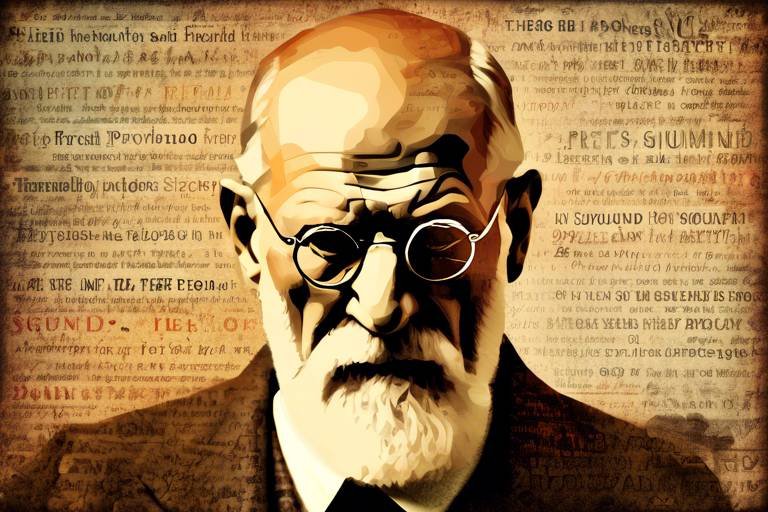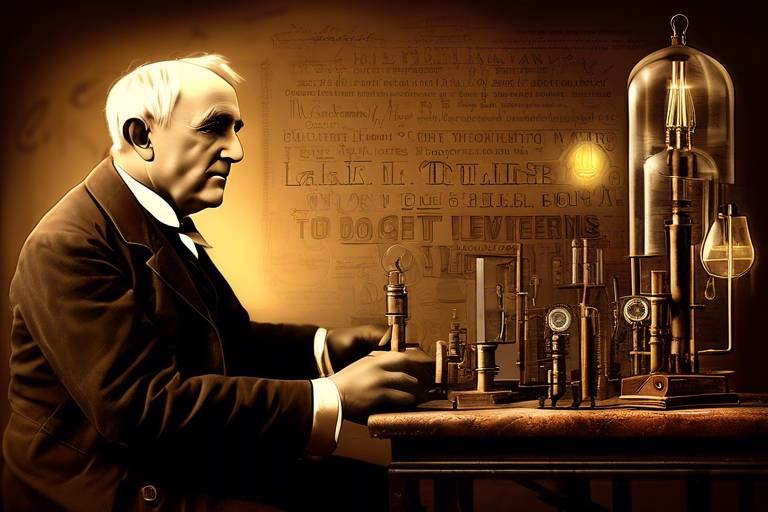The Work of Robert Oppenheimer in Theoretical Physics
Robert Oppenheimer, often referred to as the "father of the atomic bomb," was a towering figure in the realm of theoretical physics. His journey through the intricate landscapes of science not only reshaped our understanding of atomic behavior but also left an indelible mark on the ethical considerations surrounding scientific advancements. Born on April 22, 1904, in New York City, Oppenheimer's early life was steeped in a rich academic environment, which fostered his natural curiosity and intellect. This article explores the significant contributions of Robert Oppenheimer to theoretical physics, highlighting his groundbreaking research, leadership in the Manhattan Project, and lasting influence on modern science.
Oppenheimer's formative years were marked by a strong academic foundation, which laid the groundwork for his future contributions to physics. He attended Harvard University, where he initially studied chemistry but soon found his passion in physics. Under the guidance of influential mentors, he delved into the complexities of quantum mechanics and theoretical physics. Oppenheimer's thirst for knowledge led him to Europe, where he studied at the University of Göttingen, immersing himself in the revolutionary ideas of physicists like Max Born and Werner Heisenberg. This exposure to cutting-edge theories and the vibrant intellectual atmosphere of the time shaped his thinking and inspired his future work.
Oppenheimer played a pivotal role in the development of quantum mechanics, a field that fundamentally changed our understanding of the microscopic world. His contributions were not just theoretical; they provided a framework that allowed scientists to explore the behavior of particles at an atomic level. One of his key theories, the Born-Oppenheimer approximation, simplified the study of molecular systems, making it easier for scientists to understand complex chemical reactions. This approximation essentially separates the motion of nuclei and electrons in molecules, allowing for more straightforward calculations and predictions.
The Born-Oppenheimer approximation stands out as one of Oppenheimer's most significant contributions to theoretical physics. By recognizing that nuclei are much more massive than electrons, Oppenheimer proposed that the motion of the nuclei could be treated separately from that of the electrons. This simplification has had far-reaching implications in various fields, particularly in theoretical chemistry and molecular physics. It has enabled scientists to predict molecular behavior with remarkable accuracy, paving the way for advancements in fields such as drug design and materials science.
The Born-Oppenheimer approximation has profound implications in molecular physics. It allows scientists to predict chemical reactions and understand molecular structures more accurately. For instance, when chemists explore how different substances react, they can rely on Oppenheimer's approximation to simplify complex calculations. This has not only enhanced our fundamental understanding of chemical processes but has also accelerated the development of new materials and pharmaceuticals. The ability to predict molecular behavior has transformed fields like nanotechnology and biochemistry, showcasing the lasting impact of Oppenheimer's work.
Oppenheimer's work also influenced spectroscopy, a technique used to analyze the interaction between matter and electromagnetic radiation. By applying the Born-Oppenheimer approximation, scientists could enhance their analysis of molecular structures. This advancement has led to improved experimental techniques in various areas, including environmental science and astrophysics, where understanding molecular composition is crucial. The ability to dissect molecular interactions using spectroscopy has opened new avenues for research, demonstrating how Oppenheimer's theories continue to resonate in modern scientific practices.
Oppenheimer's leadership during the Manhattan Project was crucial in developing the atomic bomb. As the scientific director, he oversaw a team of brilliant minds working under immense pressure to achieve a groundbreaking goal. The ethical implications of his work, however, weigh heavily on his legacy. While the project aimed to end World War II, it also ushered in the nuclear age, raising profound questions about the responsibility of scientists in the face of such powerful technology. Oppenheimer's reflections on the moral dilemmas associated with nuclear weapons continue to inspire discussions about the role of science in society.
After World War II, Oppenheimer shifted focus to peace and science policy. He became an advocate for nuclear disarmament and responsible scientific practices, recognizing the potential consequences of nuclear proliferation. His efforts in promoting international cooperation in science and advocating for ethical considerations in research reflect his commitment to using knowledge for the greater good. Oppenheimer's transition from a wartime leader to a peacetime advocate illustrates the complexity of his character and the profound impact of his work on global scientific discourse.
As a key figure in the Atomic Energy Commission, Oppenheimer influenced nuclear policy and shaped the future of nuclear energy in the United States. His insights were instrumental in navigating the delicate balance between national security and the responsible use of nuclear technology. He advocated for measures to prevent the spread of nuclear weapons, emphasizing the need for international oversight and collaboration. Oppenheimer's role in the commission underscores his commitment to ensuring that scientific advancements serve humanity rather than threaten it.
Oppenheimer's legacy continues to impact the field of physics today. His contributions to quantum mechanics and molecular physics have paved the way for future generations of scientists to explore the intricacies of the universe. The ethical considerations he championed during his later years resonate in contemporary discussions about the responsibilities of scientists in an increasingly complex world. As we navigate the challenges of modern science, Oppenheimer's life and work serve as a powerful reminder of the profound influence that one individual can have on the trajectory of human knowledge.
- What was Robert Oppenheimer's most significant contribution to physics?
Oppenheimer's most significant contribution was the Born-Oppenheimer approximation, which simplified the study of molecular systems and advanced our understanding of quantum mechanics. - How did Oppenheimer's work impact modern science?
His work laid the groundwork for advancements in various fields, including chemistry, materials science, and nuclear policy, influencing generations of scientists. - What ethical concerns did Oppenheimer raise regarding nuclear weapons?
Oppenheimer emphasized the need for responsible scientific practices and international cooperation to prevent the misuse of nuclear technology.

Early Life and Education
Robert Oppenheimer, often referred to as the "father of the atomic bomb," was born on April 22, 1904, in New York City. His early life was steeped in an atmosphere of intellectual curiosity and cultural richness. Oppenheimer came from a well-to-do Jewish family, with his father being a successful textile importer and his mother a painter. This environment nurtured his love for science and literature from a young age. Can you imagine growing up surrounded by books and art? It’s no wonder he developed such a profound appreciation for knowledge!
Oppenheimer's academic journey began at the Ethical Culture Fieldston School, where he displayed remarkable talent in various subjects, particularly in science and languages. His passion for physics ignited during his time at Harvard University, where he earned his bachelor's degree in 1925. It was here that he encountered the works of renowned physicists, which shaped his understanding of the universe. He then pursued graduate studies at the University of Cambridge, under the mentorship of J.J. Thomson, a pivotal figure in the field of physics. This experience was like a rite of passage for Oppenheimer, providing him with the tools and insights necessary to delve into the complexities of theoretical physics.
After Cambridge, Oppenheimer moved to the University of Göttingen in Germany, where he studied under the illustrious Max Born. During this period, he not only honed his skills in quantum mechanics but also immersed himself in the rich intellectual milieu of Europe. The vibrant discussions and groundbreaking research he encountered during his time in Göttingen played a crucial role in shaping his future contributions to the field. It was here that he developed a keen interest in the behavior of atoms and subatomic particles, which would later become the cornerstone of his work.
Oppenheimer's education was not just limited to formal studies; he was also influenced by a variety of cultural and philosophical ideas. His love for literature, particularly the works of Shakespeare and Goethe, enriched his worldview and inspired his scientific inquiries. He often drew parallels between the complexities of human emotions and the intricate dance of particles in the quantum realm. This unique perspective allowed him to approach problems in physics with a creative and innovative mindset.
To summarize, Oppenheimer's early life and education were marked by a blend of privilege, intellectual stimulation, and cultural richness. These experiences laid a strong foundation for his future achievements in theoretical physics. His journey from a curious young boy in New York to a leading figure in the scientific community serves as a testament to the importance of a well-rounded education and the impact of early influences on one’s career.
| Milestone | Year | Description |
|---|---|---|
| Birth | 1904 | Born in New York City to a wealthy family. |
| Harvard University | 1925 | Earned his bachelor's degree, igniting his passion for physics. |
| University of Cambridge | 1925-1926 | Studied under J.J. Thomson, deepening his understanding of physics. |
| University of Göttingen | 1926-1929 | Studied under Max Born, focusing on quantum mechanics. |

Contributions to Quantum Mechanics
Robert Oppenheimer's contributions to quantum mechanics are nothing short of revolutionary. His work not only advanced our understanding of atomic behavior but also laid the groundwork for many modern technologies that we take for granted today. Imagine a world where the behavior of atoms and molecules is a mystery—Oppenheimer was one of the key figures who helped unlock that mystery, illuminating the complex interactions at play in the microscopic world.
One of the most significant aspects of Oppenheimer's work in quantum mechanics was his exploration of the quantum theory of radiation. He delved into how particles interact with electromagnetic fields, which is fundamental to understanding phenomena such as lasers and semiconductors. His theories provided a framework that allowed scientists to predict how particles would behave under various conditions, making it easier to manipulate them for practical applications.
Additionally, Oppenheimer's collaboration with other prominent physicists led to the formulation of several key principles that continue to be pillars in quantum mechanics today. For instance, his work on the Oppenheimer-Phillips process contributed to our understanding of nuclear reactions, particularly in the context of how deuterons interact with heavier nuclei. This has implications not only in physics but also in fields like nuclear medicine and energy production.
One of his most celebrated contributions is the Born-Oppenheimer approximation, which simplifies the complex mathematics involved in studying molecular systems. This approximation allows physicists to separate the motion of nuclei and electrons, making it far easier to calculate molecular behaviors. The significance of this approximation cannot be overstated; it has become a standard tool in theoretical chemistry and has paved the way for advancements in various scientific fields. To illustrate its impact, consider the following table that highlights its applications:
| Field | Application |
|---|---|
| Theoretical Chemistry | Predicting molecular structure and behavior |
| Material Science | Designing new materials with specific properties |
| Biochemistry | Understanding enzyme mechanisms and reactions |
Furthermore, Oppenheimer's insights into quantum mechanics have had profound implications in molecular physics. By enabling scientists to predict chemical reactions with remarkable accuracy, his work has transformed how we approach chemical synthesis and reaction dynamics. Imagine being able to foresee how different substances will interact before you even mix them together; that’s the power of Oppenheimer’s contributions!
His influence also extended to spectroscopy, a technique used to analyze the interaction between matter and electromagnetic radiation. Oppenheimer's theories provided a deeper understanding of how light interacts with molecules, leading to enhanced experimental techniques that allow scientists to probe molecular structures with unprecedented precision. This has opened up new avenues in fields ranging from astrophysics to pharmaceuticals.
In conclusion, Robert Oppenheimer's contributions to quantum mechanics are a testament to his brilliance and creativity as a physicist. His ability to simplify complex concepts and apply them to real-world problems has left a lasting legacy that continues to shape the scientific landscape today. Whether it's through the Born-Oppenheimer approximation or his work on quantum radiation, Oppenheimer's influence remains a cornerstone of our understanding of the quantum realm.
- What was the Born-Oppenheimer approximation?
It is a method used in quantum mechanics that separates the motion of nuclei and electrons in molecular systems to simplify calculations.
- How did Oppenheimer contribute to nuclear physics?
His work on nuclear reactions and the Oppenheimer-Phillips process advanced our understanding of how particles interact, influencing both theoretical and practical aspects of nuclear physics.
- What is the significance of Oppenheimer's work in modern technology?
His contributions to quantum mechanics have paved the way for advancements in various technologies, including lasers, semiconductors, and nuclear medicine.

The Born-Oppenheimer Approximation
The Born-Oppenheimer approximation is a cornerstone in the field of theoretical chemistry and quantum mechanics, fundamentally changing how scientists approach the study of molecular systems. Developed by Robert Oppenheimer and his collaborator Max Born in the early 20th century, this approximation simplifies the complex interactions between electrons and nuclei in molecules. But what does this mean for us, and why is it so significant? Let's dive deeper into the essence of this approximation and its wide-reaching implications.
At its core, the Born-Oppenheimer approximation rests on the idea that the motion of nuclei and electrons in a molecule can be separated due to their vast difference in mass. In simpler terms, because nuclei are much heavier than electrons, they move much more slowly. This allows physicists to treat the nuclei as stationary while solving the equations for the electrons. This separation not only makes calculations more manageable but also opens the door to a wealth of insights regarding molecular behavior.
To better understand the Born-Oppenheimer approximation, consider the analogy of a bustling city. Imagine the heavy trucks (nuclei) moving slowly through traffic, while the nimble cars (electrons) zip around them. Just as the trucks dictate the major routes and traffic patterns, the nuclei influence the overall behavior of the molecule. However, the faster-moving cars can change lanes and navigate quickly, allowing for a dynamic interaction that can be analyzed more easily when the trucks are treated as fixed obstacles.
The significance of the Born-Oppenheimer approximation extends beyond mere simplification. It has profound implications in various fields of science, particularly in molecular physics and spectroscopy. By facilitating the prediction of molecular structures and chemical reactions, it has become an essential tool for chemists and physicists alike. Here are some key areas where the approximation has made an impact:
- Predicting Chemical Reactions: The ability to separate electronic and nuclear motions allows scientists to predict how molecules will interact during chemical reactions, leading to advancements in materials science and pharmaceuticals.
- Understanding Molecular Spectra: The approximation enables researchers to analyze and interpret the spectra of molecules, which is crucial for identifying substances in various fields, from environmental science to astrophysics.
- Advancing Computational Chemistry: It has paved the way for the development of computational methods that can simulate molecular behavior, making it possible to explore complex systems that are otherwise difficult to analyze.
In summary, the Born-Oppenheimer approximation is not just a theoretical construct; it's a powerful tool that has revolutionized our understanding of molecular systems. By simplifying the calculations involved in studying atoms and molecules, Oppenheimer's work has had a lasting impact on the fields of chemistry and physics, enabling scientists to explore the intricate dance of particles at the quantum level. As we continue to build on his foundational work, the implications of his approximation will undoubtedly resonate through future discoveries and innovations in science.

Impact on Molecular Physics
The Born-Oppenheimer approximation revolutionized the field of molecular physics, acting as a cornerstone for understanding complex chemical systems. By simplifying the mathematical treatment of molecular interactions, Oppenheimer's work allowed scientists to decouple the motion of nuclei and electrons in a molecule. This crucial separation paved the way for more accurate predictions of molecular behavior and chemical reactions, which would have been nearly impossible without such a foundational approach.
One of the most significant impacts of this approximation is its ability to help chemists and physicists predict the outcomes of chemical reactions with remarkable precision. Prior to Oppenheimer's insights, the intricate dance of electrons and nuclei posed a daunting challenge that often led to convoluted calculations and theoretical dead ends. The Born-Oppenheimer approximation, however, made it feasible to analyze molecular systems by treating the nuclei as stationary while solving for the electronic wave functions. This simplification not only accelerated research but also opened new avenues in the study of molecular dynamics.
Moreover, the implications of this approximation extend beyond mere theoretical convenience. It has become a critical tool in various branches of science, including but not limited to:
- Theoretical Chemistry: Facilitating the calculation of potential energy surfaces, which are essential for understanding reaction mechanisms.
- Quantum Chemistry: Enabling the development of computational methods that simulate molecular systems accurately.
- Material Science: Assisting in the design of new materials by predicting how they will behave at the molecular level.
In addition to these applications, the Born-Oppenheimer approximation has been instrumental in advancing experimental techniques in spectroscopy. By providing a clearer understanding of molecular transitions, it has allowed scientists to interpret spectral data more effectively, leading to breakthroughs in identifying molecular structures and understanding their properties. This intersection of theory and experimentation exemplifies the profound impact that Oppenheimer's contributions have had on the scientific community.
In summary, the Born-Oppenheimer approximation not only simplified the study of molecular systems but also catalyzed a wave of innovation across various scientific disciplines. Oppenheimer's work continues to resonate within the realms of molecular physics, highlighting his enduring legacy as a pioneer in theoretical physics.

Applications in Spectroscopy
When we think about spectroscopy, we often picture scientists peering through intricate devices, analyzing light to uncover the secrets of the universe. Robert Oppenheimer's contributions to this field were nothing short of revolutionary. His theoretical work provided a robust framework that allowed researchers to delve deeper into the molecular world, enhancing our understanding of how molecules interact with light. This understanding is crucial, as it lays the groundwork for various applications, from identifying chemical compounds to studying the composition of distant stars.
One of the key aspects of Oppenheimer's influence on spectroscopy is the way his theories improved the accuracy of spectroscopic techniques. By applying the Born-Oppenheimer approximation, he enabled scientists to separate the motion of nuclei and electrons in molecules. This simplification is vital because it allows for more manageable calculations and predictions regarding molecular behavior. For example, in the realm of infrared spectroscopy, this approximation helps scientists analyze vibrational transitions in molecules, leading to a clearer understanding of molecular structures and interactions.
Moreover, Oppenheimer's work has paved the way for advances in various spectroscopic methods, including:
- Raman Spectroscopy: This technique relies on inelastic scattering of light and has been greatly enhanced by Oppenheimer's theoretical insights, allowing for the detailed study of molecular vibrations.
- Nuclear Magnetic Resonance (NMR): His contributions have also influenced NMR spectroscopy, which is pivotal in determining the structure of organic compounds.
- Mass Spectrometry: By improving our understanding of atomic and molecular interactions, his work has indirectly influenced the development of mass spectrometry techniques.
In essence, Oppenheimer's theoretical frameworks not only advanced our understanding of atomic and molecular behavior but also enriched the tools available to scientists. His legacy lives on in the laboratories where spectroscopy is employed to explore everything from the composition of ancient artifacts to the atmospheres of exoplanets. As we continue to push the boundaries of what we know, Oppenheimer's contributions remind us of the profound interconnectedness of theoretical physics and practical scientific applications.
Q: What is spectroscopy?
A: Spectroscopy is the study of how light interacts with matter. It is used to analyze the composition and properties of substances by observing the light they emit or absorb.
Q: How did Oppenheimer contribute to spectroscopy?
A: Oppenheimer's theoretical work, particularly the Born-Oppenheimer approximation, significantly enhanced the accuracy and applicability of spectroscopic techniques, allowing for better analysis of molecular structures.
Q: What are some applications of spectroscopy?
A: Spectroscopy is used in various fields, including chemistry, astronomy, and environmental science, for applications such as identifying chemical compounds, studying molecular interactions, and analyzing planetary atmospheres.

Leadership in the Manhattan Project
When we think about the Manhattan Project, it's impossible not to mention the towering figure of Robert Oppenheimer. His leadership was not just a role; it was a pivotal force that shaped the course of history during one of the most tumultuous periods of the 20th century. Imagine being at the helm of a project that could potentially alter the very fabric of warfare and international relations. Oppenheimer was tasked with this monumental responsibility, and he rose to the occasion with a blend of intellect, charisma, and a profound sense of duty.
Oppenheimer's journey began in 1942 when he was appointed as the scientific director of the Los Alamos Laboratory in New Mexico. This was the heart of the Manhattan Project, where some of the brightest minds in physics gathered to unlock the secrets of nuclear fission. Under his leadership, the lab transformed into a bustling hub of innovation and collaboration. Oppenheimer fostered an environment where creativity could thrive, encouraging scientists to push the boundaries of their research. He famously said, "In some sort of crude sense which no vulgarity, no humor, no overstatement can quite extinguish, the physicists have known sin; and this is a knowledge which they cannot lose."
But with great power comes even greater ethical dilemmas. Oppenheimer often found himself grappling with the moral implications of the atomic bomb. He understood that the weapon they were creating could bring about unprecedented destruction. In fact, he once reflected on the moment of the first successful test of the bomb at Trinity Site, stating, "Now I am become Death, the destroyer of worlds." This quote encapsulates the weight of responsibility he felt. He was not just leading a scientific endeavor; he was steering humanity towards a new era of warfare that would forever change the landscape of international relations.
Oppenheimer's leadership style was marked by a unique blend of visionary thinking and collaborative spirit. He recognized the importance of teamwork and often brought together diverse groups of scientists, engineers, and military personnel to work towards a common goal. This inclusivity fostered a sense of unity and purpose. He was not merely a commander barking orders; he was a mentor who listened to his team, valued their input, and inspired them to excel. The collaborative atmosphere he cultivated was crucial in overcoming the myriad challenges posed by such a complex project.
As the project progressed, Oppenheimer faced immense pressure from the U.S. government and military leaders who were eager for results. The timeline was tight, and the stakes were incredibly high. Yet, he managed to maintain a clear focus on the scientific objectives while also addressing the concerns of his team. His ability to balance these competing demands showcased his exceptional leadership qualities. He was a man who could navigate the stormy waters of scientific inquiry while also keeping an eye on the broader implications of their work.
Ultimately, the Manhattan Project culminated in the successful detonation of atomic bombs over Hiroshima and Nagasaki in August 1945. While this achievement marked a significant scientific milestone, it also left Oppenheimer with a heavy heart. He became an outspoken advocate for the responsible use of nuclear technology and a critic of the arms race that followed World War II. His leadership during the Manhattan Project was not just about creating a weapon; it was about grappling with the profound consequences of that creation.
In conclusion, Oppenheimer's leadership in the Manhattan Project was a complex tapestry woven with threads of scientific brilliance, ethical contemplation, and collaborative spirit. He was a man who understood the gravity of his work and the potential repercussions it held for humanity. As we reflect on his contributions, it’s essential to recognize that his legacy extends beyond the atomic bomb; it includes the ongoing dialogue about the ethical responsibilities of scientists in an ever-evolving world.

Post-War Contributions and Advocacy
After the dust settled from World War II and the unprecedented devastation caused by atomic bombs, Robert Oppenheimer found himself at a crossroads. The very technology he had helped to develop was now a source of global tension and fear. With a profound sense of responsibility, Oppenheimer shifted his focus towards advocating for peace and the ethical use of scientific advancements. This transition marked a significant chapter in his life, one where he sought to ensure that the horrors of nuclear warfare would not be repeated.
Oppenheimer's efforts were not just limited to personal advocacy; he actively engaged with policymakers and scientists alike. He understood that the implications of nuclear technology extended far beyond the laboratory. His position as a prominent physicist gave him a platform to speak out against the arms race and promote nuclear disarmament. It was a delicate balance he had to strike—promoting scientific progress while cautioning against its potential for destruction.
One of the most notable arenas where Oppenheimer exerted his influence was within the Atomic Energy Commission (AEC). Established in 1946, the AEC was responsible for the development and regulation of atomic energy. Oppenheimer served as its chairman, where he played a critical role in shaping nuclear policy. His vision was clear: he wanted to ensure that atomic energy would be used for peaceful purposes, such as energy production and medical applications, rather than for military escalation.
During his tenure, Oppenheimer advocated for international control of nuclear energy, arguing that collaboration among nations was essential to prevent the misuse of atomic technology. He believed that transparency and cooperation could pave the way for a safer world. His ideas were met with mixed reactions; while some applauded his foresight, others viewed him as too idealistic in a time of rising tensions.
Oppenheimer's advocacy extended beyond policy-making. He became a vocal proponent of responsible scientific practices, stressing the importance of ethics in research. He often posed the question: "What is the responsibility of scientists in a world where their discoveries can lead to mass destruction?" This rhetorical question encapsulated his belief that scientists must engage with the moral implications of their work. He urged his colleagues to consider the societal impact of their research, emphasizing that knowledge should not only empower but also protect humanity.
Despite his efforts, Oppenheimer faced significant challenges. As the Cold War intensified, the political climate became increasingly hostile towards those advocating for disarmament. Oppenheimer himself became a target of scrutiny, particularly during the Red Scare, when fears of communism permeated American society. In 1954, he faced a security clearance hearing that questioned his loyalty and past associations, leading to a dramatic fall from grace. This event was a stark reminder of the precarious nature of his position as a scientist advocating for peace in a world rife with suspicion.
Ultimately, Oppenheimer's post-war contributions and advocacy left an indelible mark on the scientific community and beyond. His commitment to ethical considerations in science continues to resonate today, reminding us that with great power comes great responsibility. The legacy of his advocacy for peace and nuclear disarmament serves as a beacon for future generations of scientists, urging them to navigate the complexities of their discoveries with caution and integrity.
- What role did Oppenheimer play in the development of nuclear policy?
Oppenheimer served as a key figure in the Atomic Energy Commission, where he advocated for the peaceful use of atomic energy and international control over nuclear technology. - How did Oppenheimer's views on nuclear weapons change after World War II?
After witnessing the devastation of the atomic bombs, Oppenheimer became a strong advocate for nuclear disarmament and responsible scientific practices. - What challenges did Oppenheimer face in his advocacy for peace?
Oppenheimer encountered significant opposition during the Cold War, especially during the Red Scare, which led to a security clearance hearing that questioned his loyalty.

Role in the Atomic Energy Commission
After the tumultuous years of World War II, Robert Oppenheimer found himself at a pivotal crossroads in his career. As the dust settled from the Manhattan Project, he transitioned into a role that would shape not just his future, but the future of nuclear policy in the United States. Appointed as the chair of the Atomic Energy Commission (AEC) in 1947, Oppenheimer became a leading voice in the discussions surrounding the ethical implications of nuclear energy and weapons. His experience as the "father of the atomic bomb" gave him a unique perspective on the responsibilities that came with such powerful technology.
Oppenheimer's leadership in the AEC was characterized by a strong advocacy for international cooperation in nuclear research and a push for nuclear disarmament. He often found himself in a delicate balancing act, advocating for scientific freedom while also addressing national security concerns. This was no small feat; he was navigating a complex landscape where fear of nuclear proliferation clashed with the potential benefits of atomic energy. Oppenheimer believed that the best way to prevent nuclear war was through transparency and dialogue, a principle that would later become a cornerstone of nuclear policy.
One of the most significant challenges Oppenheimer faced during his tenure was the growing tension between the United States and the Soviet Union. The onset of the Cold War created an environment ripe for paranoia, and many of his colleagues pushed for an aggressive nuclear arms race. However, Oppenheimer cautioned against this path, arguing that a focus on deterrence and disarmament was essential for global stability. His views often put him at odds with other prominent figures in the government, leading to heated debates about the future of nuclear weapons.
During his time with the AEC, Oppenheimer also emphasized the importance of public understanding of nuclear science. He believed that for democracy to thrive, citizens needed to be informed about the implications of nuclear technology. To this end, he supported educational initiatives and public outreach programs designed to foster a more informed citizenry. His commitment to education can be seen as an extension of his earlier work as a professor, where he nurtured the minds of young physicists and encouraged them to think critically about the world around them.
Despite his efforts, Oppenheimer's tenure at the AEC was not without controversy. His outspoken views and cautious approach to nuclear policy garnered criticism from various factions, including those who believed he was too lenient on the Soviet threat. This culminated in a series of hearings in 1954, where he faced intense scrutiny regarding his loyalty and judgment. While he was ultimately cleared of wrongdoing, the hearings marked a significant turning point in his career, leading to his resignation from the AEC and a more reclusive life thereafter.
In summary, Robert Oppenheimer's role in the Atomic Energy Commission was one of profound influence and complexity. His advocacy for ethical nuclear policies and international cooperation reflected his deep understanding of the implications of atomic energy. Although his tenure was marred by political strife and personal challenges, Oppenheimer's legacy as a scientist and a thinker continues to resonate in discussions about nuclear policy today.

Legacy and Influence in Physics
Robert Oppenheimer's legacy in the field of physics is not just defined by his groundbreaking work during the early to mid-20th century, but also by the profound impact he had on future generations of scientists. His contributions to theoretical physics, particularly in quantum mechanics and molecular physics, laid the foundation for many modern scientific advancements. Imagine a tree, with Oppenheimer's work as the trunk, supporting a vast canopy of research and discovery that has flourished in various branches of physics. His influence can be seen in numerous areas, from the development of new technologies to the ethical considerations of scientific research.
One of the most significant aspects of Oppenheimer's legacy is his role in shaping the dialogue around the ethical implications of scientific discovery. After World War II, he became a vocal advocate for responsible science and the need for nuclear disarmament. His experiences during the Manhattan Project led him to understand the potential consequences of scientific advancements when misused. Oppenheimer famously remarked, "In some sort of crude sense which no vulgarity, no humor, no overstatement can quite extinguish, the physicists have known sin; and this is a knowledge which they cannot lose." This quote encapsulates the moral responsibility he felt, and his influence continues to resonate in discussions surrounding scientific ethics today.
Oppenheimer's impact extends beyond his immediate contributions to physics; he inspired a generation of scientists to think critically about the implications of their work. He served as a mentor to many, fostering an environment of inquiry and ethical consideration. His tenure as the director of the Institute for Advanced Study in Princeton allowed him to guide young physicists, encouraging them to explore both the theoretical and practical aspects of their research. The ripple effect of his mentorship can be seen in the careers of numerous prominent physicists who followed in his footsteps.
Furthermore, Oppenheimer's influence is evident in the academic and scientific institutions that continue to thrive today. His work contributed to the establishment of various research programs and initiatives aimed at understanding the complexities of the universe. For instance, the advancements in quantum mechanics that he championed have paved the way for technologies such as quantum computing and advanced materials science.
| Field of Influence | Impact |
|---|---|
| Quantum Mechanics | Foundation for modern physics and technology |
| Molecular Physics | Enhanced understanding of chemical reactions and molecular behavior |
| Ethics in Science | Promoted responsible scientific practices and nuclear disarmament |
| Education and Mentorship | Inspired future generations of physicists |
In conclusion, Robert Oppenheimer's legacy is a rich tapestry woven with threads of scientific achievement, ethical responsibility, and mentorship. His contributions to theoretical physics not only advanced our understanding of the atomic world but also instilled a sense of moral obligation in the scientific community. As we continue to explore the mysteries of the universe, Oppenheimer's influence serves as a guiding light, reminding us that with great knowledge comes great responsibility. The questions he raised and the paths he forged will continue to inspire future physicists to pursue knowledge with integrity and purpose.
- What was Robert Oppenheimer's most significant contribution to physics?
His most significant contributions include the development of the Born-Oppenheimer approximation and his leadership in the Manhattan Project. - How did Oppenheimer influence modern science?
He shaped discussions on scientific ethics and responsible research practices, influencing how scientists approach their work today. - What is the Born-Oppenheimer approximation?
This approximation simplifies the study of molecular systems by separating nuclear and electronic motion, allowing for better predictions in chemistry.
Frequently Asked Questions
- What were Robert Oppenheimer's major contributions to theoretical physics?
Robert Oppenheimer made several significant contributions to theoretical physics, particularly in the realm of quantum mechanics. His work on the Born-Oppenheimer approximation is one of his most notable achievements, simplifying the study of molecular systems and allowing scientists to better understand atomic behavior.
- How did Oppenheimer influence the development of the atomic bomb?
Oppenheimer served as the scientific director of the Manhattan Project, where he played a crucial role in the development of the atomic bomb. His leadership and expertise were instrumental in coordinating the efforts of numerous scientists and ensuring the successful completion of the project during World War II.
- What is the Born-Oppenheimer approximation and why is it important?
The Born-Oppenheimer approximation is a method used in quantum chemistry that simplifies the calculations of molecular systems by separating nuclear motion from electronic motion. This approximation is vital because it allows chemists to predict chemical reactions and understand molecular structures more effectively.
- What were Oppenheimer's views on nuclear weapons after World War II?
After the war, Oppenheimer became an advocate for nuclear disarmament and responsible scientific practices. He expressed deep concerns about the implications of nuclear weapons and worked towards promoting peace and ethical standards in scientific research through his involvement with the Atomic Energy Commission.
- How did Oppenheimer's work impact modern physics?
Oppenheimer's contributions, particularly in quantum mechanics and molecular physics, have had a lasting impact on modern physics. His theories continue to influence research and education in these fields, inspiring future generations of scientists to explore and expand upon his foundational work.
- What is Oppenheimer's legacy in the scientific community?
Oppenheimer's legacy is multifaceted; he is remembered not only for his groundbreaking scientific contributions but also for his ethical reflections on the use of science in warfare. His role in shaping nuclear policy and advocating for responsible research practices has left an indelible mark on both physics and public policy.



















